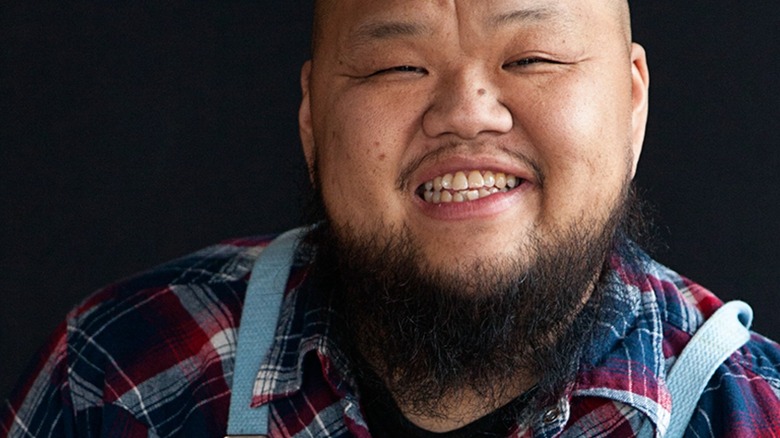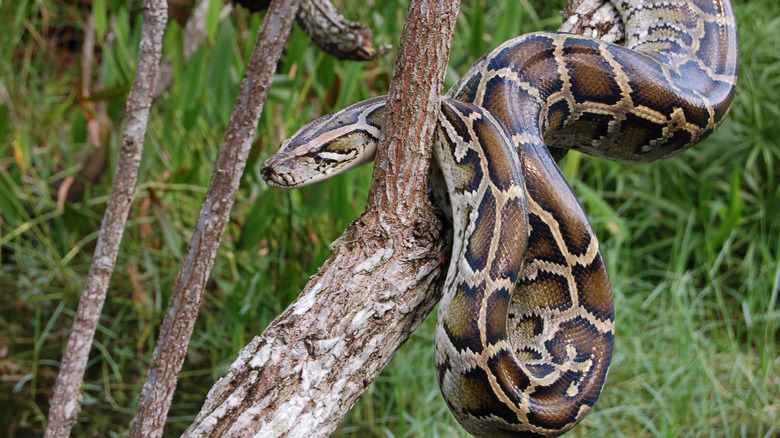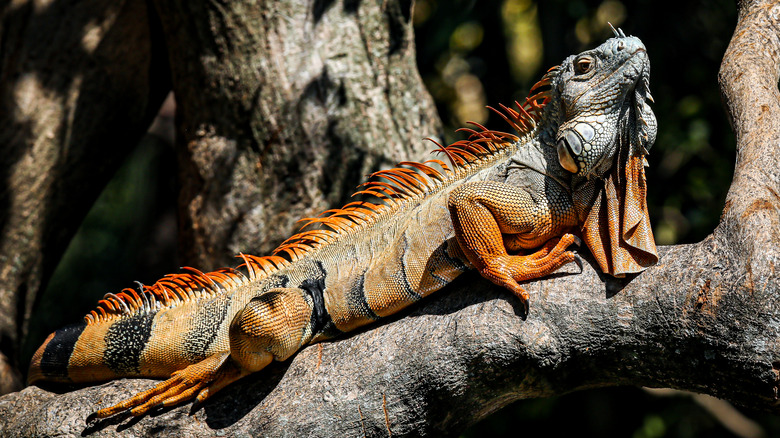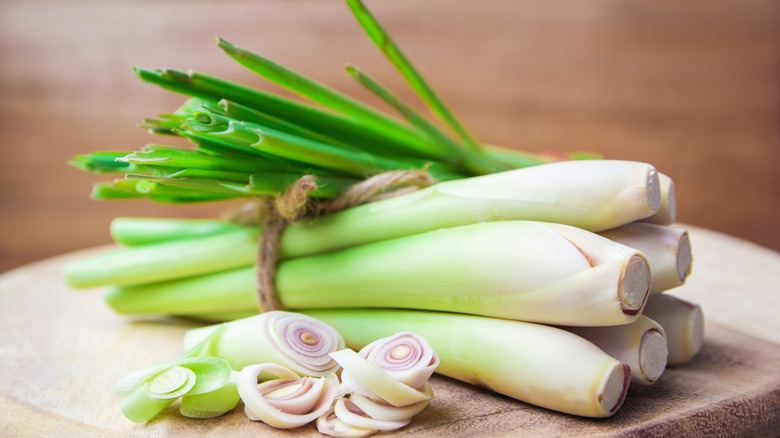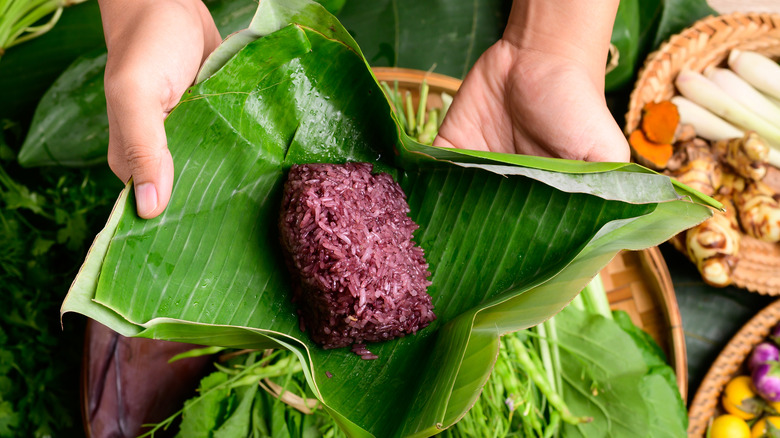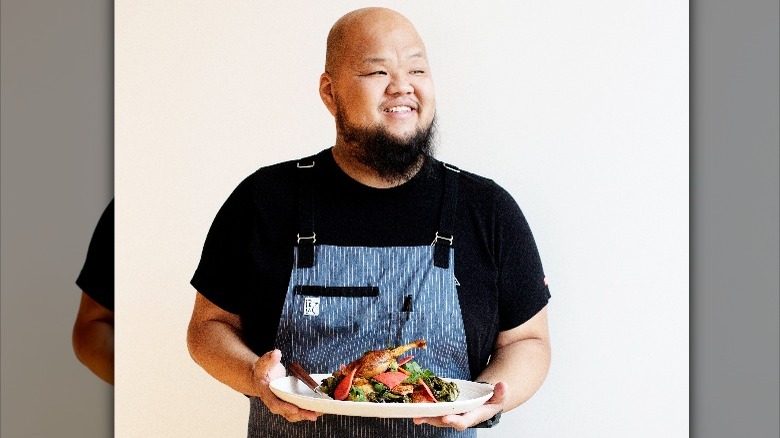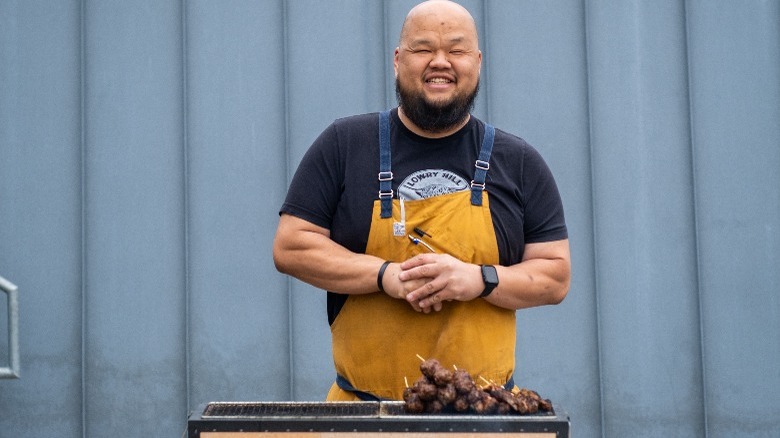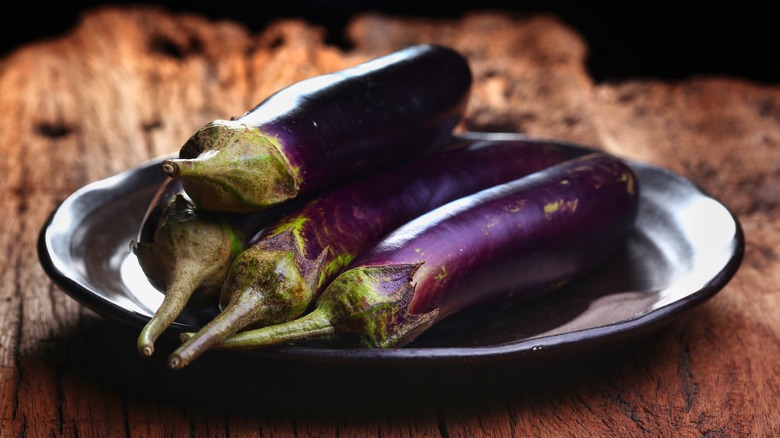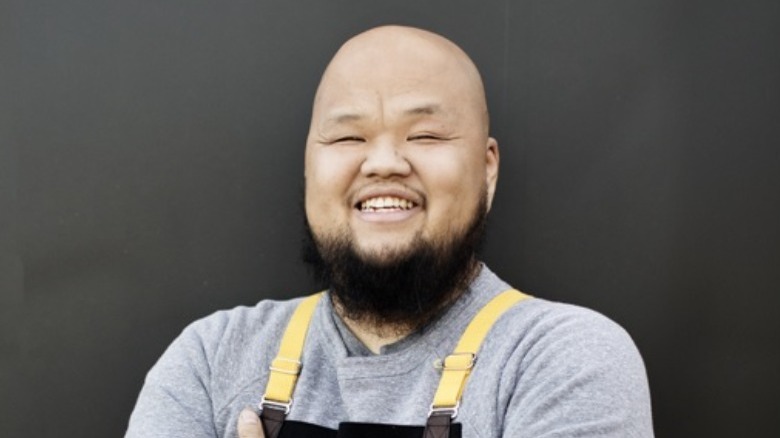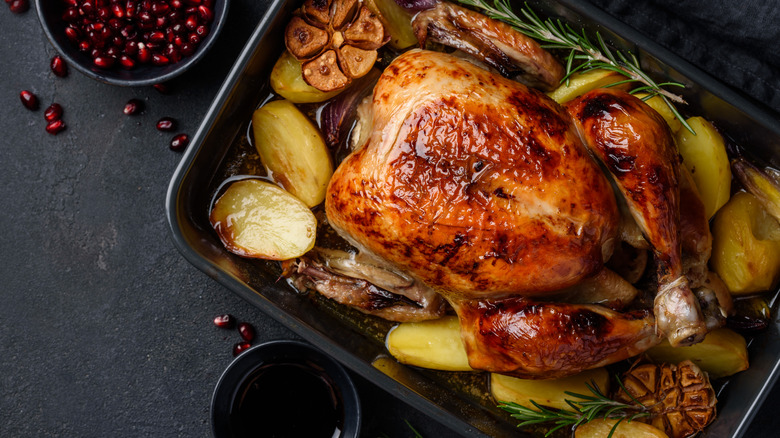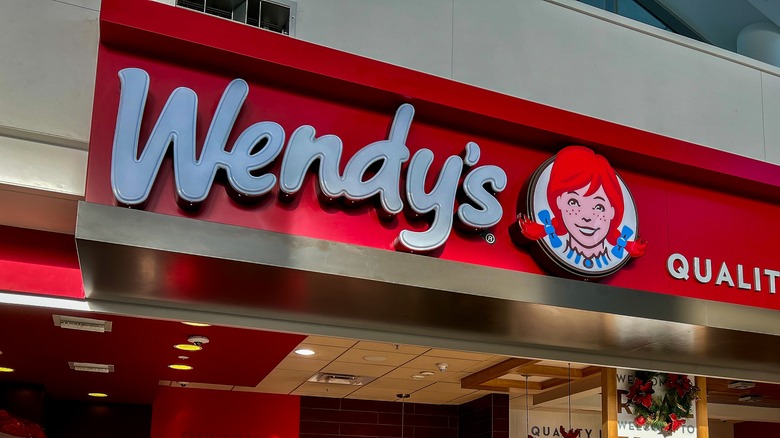Yia Vang Takes Us Back To His Hmong Roots With Feral - Exclusive Interview
Yia Vang hasn't had a lot of downtime lately. In addition to his pop-up, "Union Hmong Kitchen," the James Beard-nominated chef is about to open Vinai, a sit-down restaurant that honors the "past, present, and future" of Hmong cooking. It's a nod to Ban Vinai, the refugee camp in Thailand where Vang was born. "I always tell people this journey of food ... it's a redemption tour," Vang told Mashed in this exclusive interview. "It's going back to all those moments as a kid where you deny who you were because you were ashamed ... I always talk about how it's my way of telling my mom and dad that, 'I'm sorry that I didn't know.'"
As a Hmong kid in a predominately white school in the US, Vang's mom's eggplant dip embarrassed him. Today, it's the dish that wowed Andrew Zimmern when Vang competed on "Iron Chef: Quest For An Iron Legend." Everything Vang does in the culinary world tells a story, his latest TV show included. Set to premiere on The Outdoor Channel this November, "Feral" follows Vang as he hunts down and cooks invasive species across the United States. "The first thing I said to the executive producer Patrick McMahill was, 'Dude, this show is so Hmong, it's not even funny,'" Vang dished to Mashed. We'll let him tell you about that himself.
Yia Vang on Python-hunting in Feral
In "Feral," you hunt a python. It looks sweltering hot .. what was going through your mind?
We're in the Everglades. Dusty Crumb is the guide's name, and to get to his place, there's a dot on your Google Maps. There's no road to his house, so he lives off grid basically, but his WiFi's really good there. I don't know how. We get there, and the dude rolls out of bed, gets up and says, "Hey guys, I'm going to do a quick shower, and then let's get going." I'm like, "Okay, cool."
I was trying to hype myself up a lot. It's not that I'm scared of snakes, but the last thing you want is some 70-foot creature around you. In about an hour we hopped on the big dune buggy, and then we went right into the Everglades, and then we're walking around the Everglades. I didn't have much time to think about it. I was like, "We're doing this. This is what you signed up for." Looking back on it now, I'm like, "I don't know if I could work up that courage to do it again."
Yia Vang talks cooking iguanas
Cooking animals that aren't on everyone's "approved animal list" is nothing that's new to you ... Which animal on "Feral" pleasantly surprised you the most?
Iguanas ... When this show was first presented to me, the first thing I said to the executive producer Patrick McMahill was, "Dude, this show is so Hmong, it's not even funny." We're going to go into the wild, we're going to go into the woods, the jungle, into these waters, these streams, and we're going to find creatures, and we're going to hunt them down, harvest them, and then we're going to cook them over fire. I'm like, "This is what Hmong people do."
I told my dad, "Hey Dad, we're going to hunt iguanas," and I showed him. He was like, "Oh yeah, as a boy, that's what we hunted in the jungles of Laos" ... He proceeds to tell me how they made it [around] 50 years ago, when they were little boys growing up in the hills of Laos ... We used the exact same recipe when we were cooking it ... We were in Florida doing the iguanas, but there was this really special moment as I was cooking ... where I'm like, "Man, this is such a great connection with my father."
After the war, Dad didn't talk much about his childhood ... By the time he was 13, he started fighting for the Americans in the Vietnam War, in Northern Laos. He didn't have a childhood growing up. He didn't play t-ball. He didn't talk about going fishing with his dad, how every American kid has that. In this one moment, when I'm cooking iguana, in Florida, and I connect with him, it's like, "This is part of dad's childhood, and I get to be a part of it."
I went home, and I showed him the episode, and I showed him the pictures, and he sat there, and he giggled and laughed, and said, "That's like a Tuesday for us growing up as a boy." It was the first time I really heard him talk about growing up as a boy, these happy memories. It wasn't "We were in war. Yes, my friend died. Yes, my cousin died. Yes, I had to do this, we had to do that. Yes, it was refugee camp." It wasn't about any of that. It was about a boy who went out with his other friends, and they were shooting iguanas.
How to start using lemongrass
Lemongrass is a big ingredient in Hmong cooking. Can you give our readers your top tips for integrating lemongrass into their meals?
My mom grows lemongrass in her garden, and every year she grows a bunch of lemongrass for us. The thing with lemongrass is, after harvesting it .. you break it into three parts. The lower third and the top third, it's stalky, so you can use that for a lot of soups, braising. That middle section is a little more tender. You can chop that up, and put it in different kinds of sauce. Lemongrass, if you smash it ... it smells like Fruit Loops, no joke. You can have a savory part to lemongrass, and then there's a sweeter part to lemongrass too.
Sometimes, they use it for dessert, or you can use it for a tea. When you're sick ... take a bunch of lemongrass, take some ginger, and a little honey, and you steep it in some water to make this lemongrass ginger tea, and you can slowly sip on that. My mom does that. It's got that medicinal side to it.
Every time I chop lemongrass and I smell that smell ... with the mix of ginger, it takes me back to my grandma's kitchen ... Grandma would take ginger and lemongrass, and she'll put it in her soup ... [with] lemongrass, sometimes people are really afraid of, "What do I do? I don't know how to do it." I always tell people, if you want to get lemongrass, you've got to go to an Asian market. You can go to Whole Foods and pay arm and a leg for it, or you can go to an Asian market, where they give you a huge bundle for a $1.99. You can freeze it, too ... By freezing it, you can throw it in different soups and stocks. Lemongrass is the base of a lot of our pho that we make. It starts out as lemongrass and beef bones.
Purple sticky rice, 101
Let's go to sticky rice 101. What are the biggest mistakes people make when preparing it?
The Hmong people, historically, have been known to be some of the first people who started harvesting black rice. It started in the mountains ... of China, [about] 5,000 years ago ... black rice, it's hard to harvest and it's a little pricey, so they'll take some black rice and some white sweet rice and mix it together, and you get that purple sticky rice.
You've got to wash it and make sure you get as much starch as you can get out of it, because you don't want this rice to be very mushy ... All of these things, by the way, are what my mom taught me ... people always freak out, because they're like, "How much water should you put it in there? Do you let it soak?" I said, "You have got to know your rice." We didn't grow up with recipes. We grew up with a mother who stood right by us, and would take our hands, and put it into the rice. She wanted us to feel how the rice kernels would go between our fingers, and how that meant that all the water was getting to all the rice kernels, and to me that's so special...
Then, you soak it. A lot of times, if you're in a hurry, you soak it three to four hours. If you really want that moisture to be captured in there, you soak it overnight, and then you strain it ... The most important thing is, when you get that rice ... you want to fluff it, you want to aerate it. If you don't ... all that starch gets sticky, and then it gets mushy, and then you get more of a mochi texture, and you can't taste every kernel. That's very important.
Then, they'll mush it together ... I tell people you make an empanada type, or a papusa ... That's your edible napkin, and it's very important, because the sweetness of the rice balances out all the spice, and all the heat, in all the other dishes.
What it felt like competing on Iron Chef
We recently saw you on "Iron Chef." What was it like to be judged and recognized on that level?
First and foremost, our opponent, Gabriela Camara, they didn't tell us [about] that until the day we were in the Green Room ... and I was like, "Wait, hold on. I just watched her on Netflix 'Chef's Table.' I just watched her on 'Master Class?' No. Stop." Frankly, I was freaking out. TIME named her in the 100 most influential people in the world, and I'm like, "What?"
I grew up as a kid watching the original "Iron Chef" from Japan, the dubbed one. If you stayed up late at night during the Food Network, you would be able to catch some of those ... If you would've told 14, 15-year-old Yia that one day, years later, you're going to be here doing this, he wouldn't believe you.
You know how those little kids are always like, "One day I'm going to grow up and play football, be in the NFL and then I'll go to the Super Bowl"? That's the feeling I got when I walked in. I was like, "Oh my gosh, I'm here." I started noticing all these people, I'm like, "Alton Brown's over there. Alton Brown." I watched "Good Eats" growing up. Mark Dacascos is right there, and I'm like, "You're The Chairman." I told myself and our [team], "Act like you've been here before. Just be cool." A few them were like, "Do you guys want to do pictures?" They're like, "Yeah, you know, whatever," but inside they were going "Please, please, please."
Why Yia Vang only cooked Hmong food on Iron Chef
Were you okay with not winning?
It was so fun, and being able to introduce some of the judges to Hmong food was really special to us. We went in going, "Strictly, our whole menu is going to be Hmong food." I knew going in that if we went that route — because, again, this is a game show, you have got to play the game — we probably wouldn't win.
I'm like, "Whatever." I told the executive producer, "This is what we're going to do." They talked a little bit like, "Maybe you shouldn't. Think of more of a global view." I'm like, "Nah man, I'm good". That was really special to hear the response of Hmong people across the country, and across the world too, that responded back to that. That was super special.
There is a handful of Hmong people in France, and there was a lady who sent us an e-mail. She said, "I grew up in a different part of France, there was no Hmong people, but we were watching this because Dominique Crenn was on there." She said her and her boyfriend were watching it, and she goes, "I saw you, and I saw this food, and I was like, I know that food." I was tearing up reading this. At the end of the day, we felt we made a good choice of going this route. We were very proud of it.
The secret to Yia Vang's Andrew Zimmern-approved Eggplant dip
Andrew Zimmern was impressed with your eggplant dip, particularly. What's the secret?
It's funny, because that eggplant dip is our version of "when you come home from school." My white friends, when they come home from school, Mom would have peanut butter and jelly sandwiches or bologna sandwiches ... or grilled cheese. That eggplant dish was like our version of that. As a kid, I hated it, because it's like, "I want my PB&J".
Basically it's a Japanese or Thai eggplant, and they would roast it over fire ... It's almost baba ghanoush, if you think about it, from the Middle East somewhere. It's different in how we flavor it. It's lime juice, garlic, Thai chili, and cilantro in a mortar and pestle. You mash all that, and then you get the eggplant and you mash all that in, and it's this dip with sticky rice.
I, personally, was always a little embarrassed about it, especially when you're at school and teachers go, "Okay, what's your favorite snack when you go home?" I would have to lie, because you don't want to be like, "We make this roasted eggplant mush thing that we eat with sticky rice." As a kid that was growing up in a predominantly white school, you get laughed at.
This journey of food, the restaurant, and stuff that I'm doing is a redemption tour. It's going back to all those moments as a kid where you deny who you were because you were ashamed. I always talk about how it's my way of telling my mom and dad that, "I'm sorry that I didn't know." I get emotional ... That's why I fight tooth and nail for this food, but it's also a way of me telling all the younger Hmong kids that, "It's okay. You might get made fun of, but don't worry. As you get older, your friends, they're going to come to you, and they're going to ask what you're eating."
We've had Hmong kids come up to us and say, "I can tell my friends what I'm eating, and with your restaurant, people are really drawn to it, and they want to talk about that food, and it's more common, it's more normal." That dish, to me, it is a very simple dish. You can make it in 15 minutes, but to me, how deep does it mean in my heart?
The weight of Yia Vang's American citizenship
Last October, you became an American citizen. You wrote that citizenship meant to "carry on the hopes and dreams of Hmong men and women who fought and died for the idea of that country where they can have freedom." Can you reflect on how that's going?
I remember when that happened, and I was so over excited. I put it on social media, and I have a cool friend, and he messaged me. He goes, "Dude, do you really want to be an American citizen? America right now? A lot of people don't like America." I said, "It's different when you're born into citizenship, [rather] than earning citizenship."
I didn't grow up with a grandfather from my dad's side. He died in the war. As a kid growing up in school, everyone talked about going fishing with your grandpa, going up to grandma's cabin ... I never knew what that was, because he died fighting a war that wasn't his. He died as a patriot of America without ever getting a title of being a citizen of America. My uncles, they fought for a country that eventually denied them. When they got to this country, the citizens of this country who they fought for said, "Go back to your own country." My dad is a true patriot. He was a patriot of America, before he even stepped foot in America.
When I got that citizenship ... This is for those who couldn't do it. This is for those who died and that didn't make it here. Now, when I say "I bear the weight," it's a good weight on my shoulder, knowing that we get to talk about them, knowing that their heritage, and their legacy echoes through us.
Yia Vang's Thanksgiving traditions
You grew up celebrating Thanksgiving, and rented out community centers because your family is so big. What were your favorite side dishes, and how do you prepare a Turkey?
I was asked about Thanksgiving, "Do you guys do Hmong food, or do you do American food?", and I'm like, "Yes, we do both." That's what I loved about Thanksgiving. We didn't have to pick a side. We would have steamed rice rolls — "faum kauv," that's what Hmong people call it. We'll have egg rolls, and we'll have different kinds of noodle dishes. We'll have all of that, plus, on the other hand, we'll have your turkey, and we'll have your stuffing, and we'll have your gravy also. I don't really have a favorite. I know that I can mix everything, qnd that's so cool. That's one of the most fun things about Thanksgiving.
[My] uncles always think that they have the perfect recipe to make the most moist Turkey, every year. Now, my cousins, who are my age and mid-30s, they're all like, "Maybe we can start doing the turkey." I love to keep it real simple. I tell people, "Roasting a turkey is roasting a really big chicken." It takes time, you have to break it down. The best thing is that I always spatchcock the turkey, because that's the only way to get the whole turkey to be roasted evenly. The Norman Rockwell photo of that turkey, that big picture that is so iconic. I'm like, "That doesn't work in real life. It's fake." I am a huge sucker for leftover turkey. That's my jam right there.
What do you do with the leftover turkey?
I'm old school. Eating cold turkey later, after Thanksgiving dinner, at 10:00, 10:30 at night is my favorite thing to do. I strip it down, and then, I do the open face sandwich. It's a big chunk of bread, mashed potatoes, turkey, and the gravy over it. It reminds me of school lunch, because that's what they would do too — the open face sandwich. I love it.
Yia Vang reveals his Wendy's weakness
You're big into Wendy's as a late night snack. What is your preferred order?
Right now they have the Five for $5, so I do that. I'm not a big fan of fries, so if I'm super hungry, I'll eat the fries, but most of the time I don't ... I always add either the junior bacon cheeseburger or the double stacker with cheese. It's really bad.
You know what the worst part is? You smell like it. When I get done, I don't even use the napkin to wipe my mouth. I'll use the bag, then I throw it in the bottom of my truck, and the whole car smells like Wendy's. I roll the windows down when I'm driving, I don't care how cold it is, because I have to air it out. It's really bad. I try not to do it anymore, because I have a nutritionist and a trainer who's like, "I don't know if we can do that anymore."
Yia Vang's new show, "Feral," premieres Monday, November 28, on the Outdoor Channel.
This interview has been edited for clarity.
